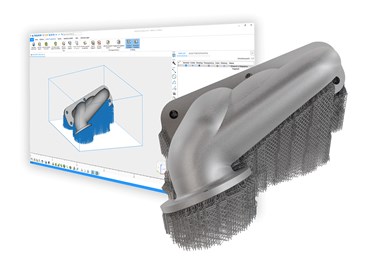Materialise Software Module Optimizes Data and Build Preparation for Metal LPBF
The e-Stage for Metal+ software uses physics-based modeling to improve automated support structure generation for laser powder bed fusion.
By automating support structure generation with Materialise’s software, additive manufacturers can streamline the 3D printing process. Source: Materialise
Materialise’s e-Stage for Metal+ software optimizes data and build preparation for laser powder bed fusion (LPBF) systems using physics-based modeling to automate the support structure generation. The solution is designed to help make metal additive manufacturing (AM) more economically viable.
LPBF is one of the leading segments for AM and may also be one of the most complex technologies to use, the company says. According to an independent survey commissioned by Materialise, two main factors holding companies back from adopting 3D printing are a lack of knowledge and the cost associated with the production process. Both challenges play a central role during build preparation for LPBF.
“By automating support structure generation with Materialise’s software, you can streamline your 3D printing process,” says Mirco Schöpf, EOS product line manager software. “It simplifies support removal, reduces support volume up to 80%, eases powder extraction and decreases build plate machining after an effortless part removal. We look forward to exploring e-Stage for Metal+ and discovering additional benefits.”
The software utilizes physics-based modeling to calculate where deformations during the 3D printing process will occur and automatically generates needle-thin and cone supports where needed. Combining the two support types optimizes stability and heat distribution during the 3D printing process, helping to avoid part deformation while reducing postprocessing efforts. This is said to eliminate the compromise between part quality and overall production costs, making the AM process more economically viable and straightforward to adopt. Automated tools such as e-Stage for Metal+ lower the learning curve, enabling users to connect the software to any machine and quickly optimize support generation.
“Metal AM users tend to overload parts with support structures during manual data preparation,” says Ian O'Loughlin, metal practice lead at Materialise. “They want to avoid defects and the costs associated with reprinting the parts. That’s why intelligent tools like e-Stage for Metal+ are crucial. Automating support structure generation at the sweet spot of printability and required supports saves time, material and postprocessing costs.”
The e-Stage for Metal+ software is a module for Magics, Materialise’s data and build preparation software, and core element of its 3D Print Suite. Magics is a technology-neutral software offering compatibility with nearly all import file formats and connectivity to all major 3D printing technologies. It provides users with advanced control and automation for their workflows.
“We are continuously enhancing our software solutions to support AM users in their daily business,” says Lieve Boeykens, solution strategist at Materialise. “Automation can support AM users in bridging knowledge gaps to adopt the technology faster, accelerating return-on-investment and helping them lower the overall production cost. Materialise’s e-Stage for Metal+ helps companies achieve economic viability.”
Related Content
-
Aircraft Engine MRO: How Additive Manufacturing Plus Robotic Finishing Will Expand Capacity for Blade Repair
AM offers the chance to bring fast, automated processing to individualized, part-by-part restoration of turbomachinery. A cell developed by Acme Manufacturing and Optomec is able to automatically repair 85,000 unique aircraft engine blades per year.
-
ActivArmor Casts and Splints Are Shifting to Point-of-Care 3D Printing
ActivArmor offers individualized, 3D printed casts and splints for various diagnoses. The company is in the process of shifting to point-of-care printing and aims to promote positive healing outcomes and improved hygienics with customized support devices.
-
Ultimaker 5.0 Cura Enables Finer, Faster Prints
The software’s enhanced slicing engine is said to enable thinner walls and finer details in additive manufacturing.
















